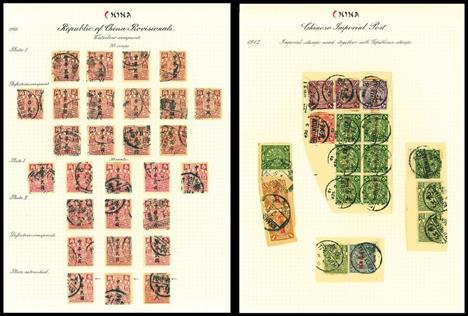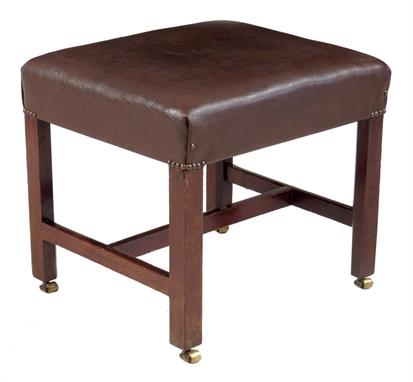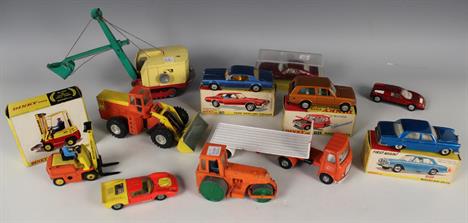China1912 Republic OverprintCollections and RangesA very attractive collection on leaves featuring several plate varieties, which includes Shanghai with three pages of singles and multiples with the Chinese Post Office roller cancellation on values to 50c. (9), 5c. misplaced overprint (4), 16c. broken third character (8) and misplaced overprint (2), 30c. retouched character (2), 50c. misplaced overprint (5) plus some better postmarks including red tombstone and Thailand packet boat. London overprint including 1c. retouched "one" (4) and broken "one" (4), 2c. with various errors to stamp and surcharge, 30c. plate retouch (3), some interesting postmarks including coloured, Hong Kong Western Branch and others plus several combination pieces. A fine and detailed collection with many unusual and specialised items, well worth inspection. Ex. Sir Percival David. Photo
We found 19703 price guide item(s) matching your search
There are 19703 lots that match your search criteria. Subscribe now to get instant access to the full price guide service.
Click here to subscribe- List
- Grid
-
19703 item(s)/page
λA George IV rosewood writing / draughtsman`s table, with a hinged leather lined writing surface on a ratchet, flanked by two hinged compartments, one with divisions for pens and ink, above a cedar lined frieze drawer, the reverse with a slide, on brass roller castors, 30in (75.7cm) high, 36in (91.3cm) wide, 18in (45.7cm) deep.
Two Chad Valley (Harborne, England) tinplate clockwork Racing Cars: one in pale blue and mid-blue, 29cm long, and the other in mid-green and cream, 19.5cm long. Both with balloon tyres and flat driver figure, clockwork motors in working order. F/P, surface corrosion and paint loss. Together with a tinplate Steam Roller, clockwork model finished in green with overhead canopy, red roller and wheels, and black funnel. When motor wound model moves backwards and forwards. Length 30cm. G/F, some wear to wheels and roller dented. (3)
A 32 BORE OTTOMAN FLINTLOCK HOLSTER PISTOL, TURKEY, LATE 18TH/EARLY 19TH CENTURY with tapering barrel retained by two chased silver bands (one associated), encrusted with gold scrollwork and pellets over the breech (rubbed, small losses), gold inlaid stepped lock signed in gold in imitation of a European maker, fitted with gold decorated cock pierced with scrollwork, rainproof pan and roller, gold-lined pan, full stock profusely inlaid with silver and gilt wire scrolls within a plaited silver wire framework, signed en suite with the lock beneath the fore-end, applied with a large chased silver band over the spine of the butt and with two gold-encrusted steel ovals behind, silver mounts comprising pierced scrollwork side-plate, spurred pommel decorated with scrolls and engraved details, trigger-guard with elaborately pierced finial, and imitation silver ramrod (areas of wear, small losses) 35.5 cm; 14 in barrel
** A RARE NORTH INDIAN FLINTLOCK BLUNDERBUSS, EARLY 19TH CENTURY with swamped barrel belled towards the muzzle, formed with raised mouldings behind the muzzle and ahead of the breech, the latter incorporating a standing back-sight, engraved shaped tang, engraved lock in the European taste, fitted with engraved cock (the upper portion missing), semi-rainproof pan and roller, full stock (fore-end with small cracks and chips), carved with foliage about the tang, hooked butt formed with a characteristic bifurcated fishtail terminal, iron mounts including scrolling trigger-guard with pineapple finial, and a pair of ramrod-pipes, and brass two piece side plate and barrel bolt escutcheons (one escutcheon and the ramrod missing) 77 cm; 33 3/8 in barrel A flintlock gun of related form is illustrated R. Hales 2013, p. 279, no. 680.
A .500 CALIBRE FLINTLOCK RIFLED OFFICER`S PISTOL MADE FOR PRINCE FREDERICK OF BADEN (1756-1817) BY DURS EGG, LONDON, CIRCA 1790 with browned twist octagonal swamped sighted multi-groove rifled barrel, the breech stamped with the gold-lined barrelsmith`s mark, inlaid with a gold line and gold lined vent, engraved case-hardened tang decorated with a trophy-of-arms, signed stepped lock with sliding tail safety-catch, engraved with trophies, foliage and a sunburst, fitted with semi-rainproof pan and steel with roller, set trigger, figured walnut full stock carved with a bouquet behind the tang, cut with characteristic pineapple chequering over the butt, engraved steel mounts comprising trigger-guard (bent) decorated with a trophy-of-arms on the bow and with pineapple finial, pear-shaped butt-cap, and a pair of ramrod-pipes, inset with a silver plaque engraved with the owner`s initial `F` enclosed by the motto of the Polish Order of the White Eagle, `Pro Fide Rege et Lege`, and horn tipped ramrod 25.5 cm; 10 in barrel See footnote to previous lot.
A .550 CALIBRE GERMAN FLINTLOCK SPORTING RIFLE WITH ENGLISH LOCK BY DURS EGG, CIRCA 1800 with octagonal swamped sighted barrel with some blued finish, rifled with eight grooves, stamped with the brass-lined barrelsmith`s mark, the letters `BL` divided by a flaming torch, over the breech, signed stepped bevelled lock engraved with a hound on the tail, semi-rainproof pan and roller, double set trigger, figured walnut full stock impressed `64` behind the lock, carved with rococo flowers in low relief (cracked through and repaired), the butt with raised cheek-piece and patchbox with moulded sliding cover, steel mounts including trigger-guard with finial of stylised pineapple form, and butt-plate with tang of shaped outline, and horn fore-end cap 65.8 cm; 25 7/8 in barrel
A 14 BORE FLINTLOCK SPORTING GUN BY HARVEY WALKLATE (1) MORTIMER, MAKER TO THE KING, LONDON, CIRCA 1790 with browned barrel of Spanish form, fitted with silver `spider` fore-sight, chiselled at the median and signed `H. W. Mortimer Maker to the King London` over the breech, stamped with the barrelsmiths mark and London proof marks twice beneath, engraved with a band of beadwork and gold-lined vent, engraved tang, signed, stepped bevelled lock fitted with engraved cock, steel with roller, humped spring, figured walnut full stock (small cracks), impressed `74` behind the lock, finely chequered grip, engraved blued steel mounts including trigger-guard with pineapple finial and butt-plate engraved with a trophy-of-hunting, three ramrod pipes, and sling swivel (later ramrod) 96 cm; 37 23/4 in barrel Harvey Walklate (1) Mortimer (1753-1811) was appointed Gunmaker to George III in 1783.
A FINE AND RARE .600 CALIBRE FRENCH PRESENTATION FLINTLOCK RIFLED CARBINE BY BOUTET, DIRECTEUR ARTISTE, MANUFACTURE À VERSAILLES, NO. 277, CIRCA 1800-05 with blued swamped octagonal polygroove rifled barrel, fitted with windage adjustable fore-sight on a punched and gilt bed, signed in italics on the left of the breech `Boutet Directeur Artiste No. 277`, inscribed on the right `Manufre à Versailles` and stamped beneath with the control mark of Daniel Boussavy, and the abbreviated italic inscription `Manu` and `V lles.` in italic, gold lined oval vent, the top of the breech chiselled with a garland of flowers beneath a triangular panel filled with a flower head, all on a punched and gilt contrasting ground, stamped with a series of marks including `Boutet` in miniscules, and `NB` (Neue Støckel 95), fitted with blued back-sight of two folding leaves, engraved tang decorated with neo-classical ornament including a pair of entwined serpents enclosing a smoking urn, stepped lock with moulded borders (small dents), signed `Boutet Directeur Artiste`, chiselled with beadwork along the step, fitted with engraved cock decorated with a garland of flowers, gold-lined pan engraved with a pair of volutes, with scrolling rear fence, blued steel spring with roller, engraved button safety, and detents, steel engraved en suite with the pan, set trigger, figured walnut full stock, impressed `47`, carved with a panel of fine chequering over the fore-end and the grip, carved with a moulding along the length of the barrel on each side and inlaid with a running design of silver foliage beneath, the muzzle carved with anthemion and neoclassical foliage (one very small repaired crack), further foliage about the rear ramrod-pipe and the lock, each enriched with further panels of leafy conventional foliage in engraved silver, the tang enclosed with a raised fluted moulding and a pair of neo classical demi flowers, the butt with carved raised cheek-piece inset with a large pierced and engraved silver flowerhead, the base of the butt encircled by a broad panel of silver pierced chased and engraved with geometric panels filled with scale pattern and a band of waves (a small area with minor lifting), burnished steel mounts comprising chiselled trigger-guard with a neo-classical flaming urn finial, the bow with foliage at each end and an engraved rear finial, the rear portion continued by a scrolling panel of pierced ebony decorated with neo classical foliage (very small chips), two-piece vestigial side-plate engraved with a garland and a flowerhead respectively, the right enclosed by two engraved silver dragons breathing thunder-bolts, butt-cap chiselled with an urn on the tang, rear ramrod-pipe chiselled with a leafy garland and beadwork, four further faceted ramrod-pipes with beadwork mouldings, contemporary horn-tipped wooden ramrod, and remaining in very good condition throughout 70.5 cm; 27 ¾ in barrel The Annuaire of the Versailles Manufactory for this period includes the following entry: Prince de Bade - Carab. doub. détente, acier cis. damasq., placage argent, fr. 6075 AN XI (September 23, 1802 to September 23, 1803) The use of silver inlay in the stock and steel mounts, as opposed to silver mounts, might suggest presentation to a high ranking military officer. The proximity to France of the territories of Charles-Frederick, Margrave of Baden (1756-1811), together with his initial opposition to the French revolution and its effects, resulted in the devastation of Baden by French armies in the mid-1790s. Thereafter, having indemnified France and ceded some territory to that republic, Baden remained under the sway of its powerful neighbour until 1813. In November 1802, the margrave - having lost his eldest son in the previous year and clearly prescient regarding the ambitions of Napoleon - wrote France`s First Consul a fulsome letter in which he thanked Napoleon for his continuing protection and assured him of his admiration and loyalty: significantly, he chose to send his third - and favourite - son, Prince Louis, to France with the letter. In April 1806, by which time the margrave had become an electoral prince, ties between Baden and France were strengthened by the arranged marriage of the elector`s grandson and heir, Prince Charles, to the Emperor Napoleon`s adopted niece and newly created imperial princess, Stéphanie de Beauharnais. The elevation of the elector to the rank of grand-duke - an elevation approved and arranged by Napoleon - followed in July 1806 and further bound Baden to the fortunes of Napoleonic France. Elements of Baden`s small army served alongside that of France in several campaigns between 1805 and 1812: against Austria in 1805, Prussia in 1806, Britain (in Spain) in 1809 and Russia in 1812. Prince Charles, heir to his grandfather after 1801 and husband of Napoleon`s adopted niece from April 1806, was welcomed by personal letter into Napoleon`s military entourage in September 1806 - `J`approve le désir que vous avez de faire la guerre`. The prince was summoned to meet Napoleon at Bamberg early the following month and was with the French army at its decisive victory over that of Prussia at Jena on 14th October 1806, after which Napoleon wrote to Prince Charles`s widowed mother to reassure her that her son had done well at his first battle - `...il s`est bien comporté à la bataille et supporte bien la fatigue`. In 1807, Prince Charles commanded the Baden contingent at the siege of Danzig and continued on active service until 1808. Succeeding his grandfather in 1811, Charles maintained Baden`s support for France until the battle of Leipzig in 1813 demonstrated that the tide of war was no longer flowing in France`s favour. The political, military and personal ties that bound Baden to France from the late 1790s until 1813 must account for the existence of this carbine in the descendant family of the Grand Duke of Baden. It is possible that it originally belonged either to Prince Louis, who visited Napoleon at his father`s behest in 1802 and remained in Paris for some years, or to his nephew, Prince Charles, who served alongside Napoleon in his campaigns between 1806 and 1808: given the martial qualities of the weapon, the latter seems the most likely of the two princes to have been its original owner. Nicolas-Noël Boutet (1761-1833) the distinguished maker of armes de luxe inherited the position of gunmaker to Louis XIV from his father-in-law, Pierre de Sainte (active 1747-88). In 1792 he became technical Director at the new Versailles Manufactory and in 1800 rose to Directeur Artiste with overall control. He held this position until the closure of the manufactory in 1818. Boutet died fifteen years later in poverty, his career having survived six French Political regimes. Daniel Bouyssay was controller at the Versailles Manufactory from Year II (1793-4) until Year XIV (1805).
A STAMP ROLLER, maker Mappin & Webb, hallmarks indistinct, of plain swept oblong form supporting a clear glass roller, 3" x 2 1/2", base 1oz 19dwts, together with an Edwardian capstan inkwell, maker probably S Blankensee, Chester 1909, the hinged cover with blue and white guilloche enamelling, 2 1/2" diameter (2)
A small collection of Dinky Toys vehicles, comprising a No. 160 Mercedes 250SE with stop lights, a No. 174 Ford Mercury Cougar, a No. 192 Range Rover, a No. 404 Conveyancer fork lift truck, all boxed, a No. 190 Monteverdi, within a plastic display case, a Ford 40, a No. 224 Mercedes-Benz CIII, an AEC articulated lorry, an Aveling Barford road roller, a Yale tractor shovel and a No. 975 excavator (playwear and scratch marks, boxes creased, torn and scuffed, plastic case cracked).
A small collection of Dinky Toys and Supertoys commercial vehicles, comprising a No. 251 Barford road roller, a No. 419 Leyland Comet `Ferrocrete`, a No. 512 Guy flat bed truck , a No. 522 Big Bedford truck, a No. 982 Pullmore car transporter and ramp, a motocart, a wheelbarrow and an elevator loader (playwear and paint chips).
A Victorian pavé set turquoise vinaigrette, the vinaigrette of hinged globe form, 18mm diameter, pavé set with rows of graduated turquoise cabochons. The interior with a pierced, gold, engraved, scroll form grille, to a polished gilded interior, a matched circular, domed brooch, and a pair of earrings, similarly set (4) CONDITION REPORT: Vary coloured turquoise with some obvious replacements. Some with surface damage or cracks. Nice tight hinge to the vinaigrette. Later roller catch to the brooch. Later posts to the earrings.
A collection of objects of interest comprising a large Mdina paperweight, a dog head desk clip, a roller blotter, an antler handle magnifying glass, a 1982 Falklands proof coinage set, a block ,mounted oil stone, a brass Tiger Tops Nepal hunting lodge ashtray, a tooled leather perpetual desk calendar, a boxed twin set of playing cards and a 2002 commemorative £5 coin (10).
MATCHBOX 1 to 75 Series 3 x Models - MB 1d Aveling Barford DieselRoad Roller Green Body and Driver, twin rivet baseplate and Red plastic Rollers (Mint in an Excellent Type D Box) - MB3b Bedford Tipper Truck - Grey Body/Maroon Chassis/Black wheels (Mint in a Good Type D Box) - MB14c Off White Bedford Lomas Ambulance(Near Mint in a Near Mint Type D Box)
George V silver mounted roller blotter having engine turned decoration, the central handle mounted with a golf ball, makers Mappin & Webb, Birmingham 1934, 13.5cm wide Golf ball handle is somewhat pushed down into the surface of the piece and is slightly buckled - ** General condition consistent with age
-
19703 item(s)/page


























































